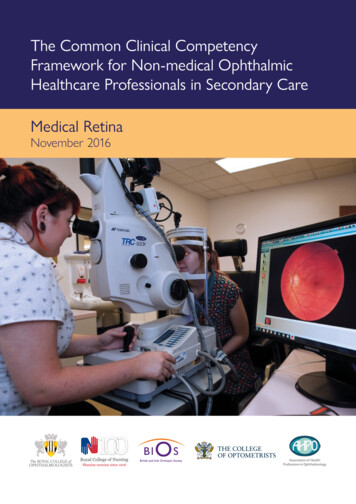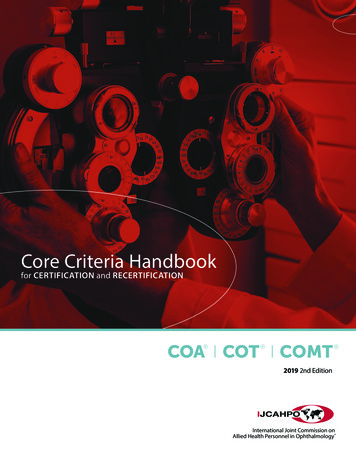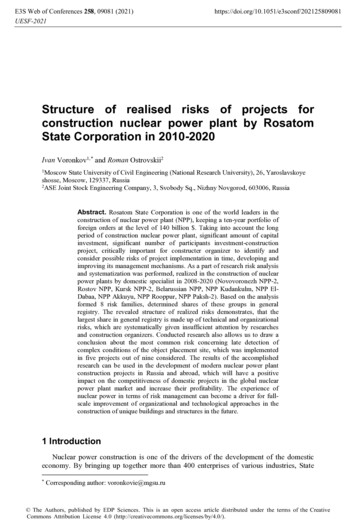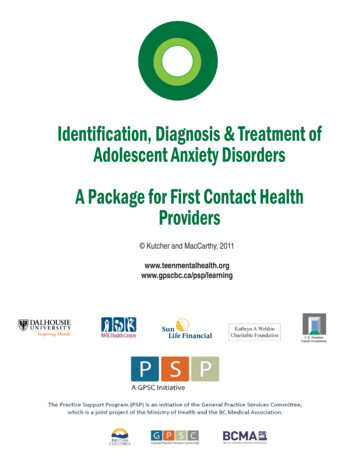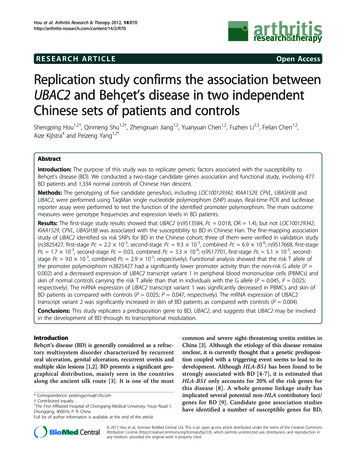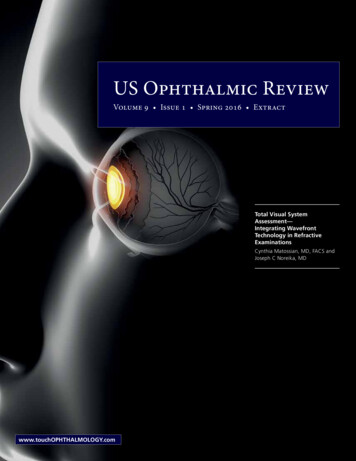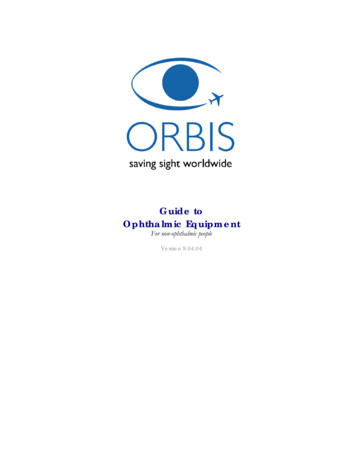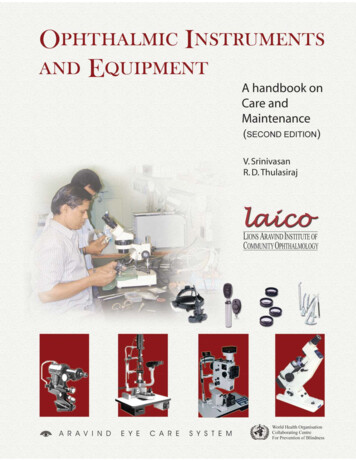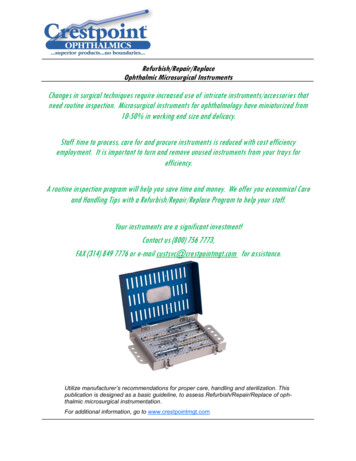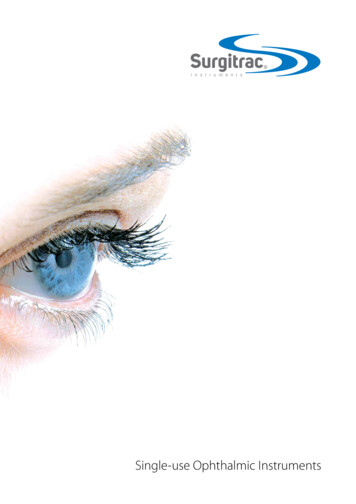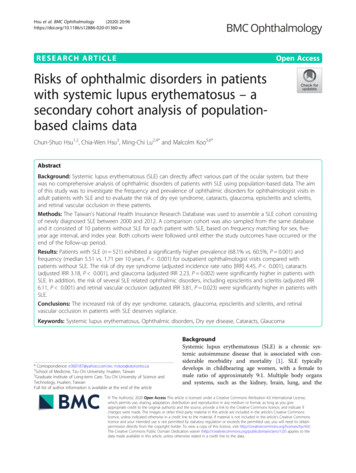
Transcription
Hsu et al. BMC Ophthalmology(2020) EARCH ARTICLEOpen AccessRisks of ophthalmic disorders in patientswith systemic lupus erythematosus – asecondary cohort analysis of populationbased claims dataChun-Shuo Hsu1,2, Chia-Wen Hsu3, Ming-Chi Lu2,4* and Malcolm Koo5,6*AbstractBackground: Systemic lupus erythematosus (SLE) can directly affect various part of the ocular system, but therewas no comprehensive analysis of ophthalmic disorders of patients with SLE using population-based data. The aimof this study was to investigate the frequency and prevalence of ophthalmic disorders for ophthalmologist visits inadult patients with SLE and to evaluate the risk of dry eye syndrome, cataracts, glaucoma, episcleritis and scleritis,and retinal vascular occlusion in these patients.Methods: The Taiwan’s National Health Insurance Research Database was used to assemble a SLE cohort consistingof newly diagnosed SLE between 2000 and 2012. A comparison cohort was also sampled from the same databaseand it consisted of 10 patients without SLE for each patient with SLE, based on frequency matching for sex, fiveyear age interval, and index year. Both cohorts were followed until either the study outcomes have occurred or theend of the follow-up period.Results: Patients with SLE (n 521) exhibited a significantly higher prevalence (68.1% vs. 60.5%, P 0.001) andfrequency (median 5.51 vs. 1.71 per 10 years, P 0.001) for outpatient ophthalmologist visits compared withpatients without SLE. The risk of dry eye syndrome (adjusted incidence rate ratio [IRR] 4.45, P 0.001), cataracts(adjusted IRR 3.18, P 0.001), and glaucoma (adjusted IRR 2.23, P 0.002) were significantly higher in patients withSLE. In addition, the risk of several SLE related ophthalmic disorders, including episcleritis and scleritis (adjusted IRR6.11, P 0.001) and retinal vascular occlusion (adjusted IRR 3.81, P 0.023) were significantly higher in patients withSLE.Conclusions: The increased risk of dry eye syndrome, cataracts, glaucoma, episcleritis and scleritis, and retinalvascular occlusion in patients with SLE deserves vigilance.Keywords: Systemic lupus erythematosus, Ophthalmic disorders, Dry eye disease, Cataracts, Glaucoma* Correspondence: e360187@yahoo.com.tw; m.koo@utoronto.ca2School of Medicine, Tzu Chi University, Hualien, Taiwan5Graduate Institute of Long-term Care, Tzu Chi University of Science andTechnology, Hualien, TaiwanFull list of author information is available at the end of the articleBackgroundSystemic lupus erythematosus (SLE) is a chronic systemic autoimmune disease that is associated with considerable morbidity and mortality [1]. SLE typicallydevelops in childbearing age women, with a female tomale ratio of approximately 9:1. Multiple body organsand systems, such as the kidney, brain, lung, and the The Author(s). 2020 Open Access This article is licensed under a Creative Commons Attribution 4.0 International License,which permits use, sharing, adaptation, distribution and reproduction in any medium or format, as long as you giveappropriate credit to the original author(s) and the source, provide a link to the Creative Commons licence, and indicate ifchanges were made. The images or other third party material in this article are included in the article's Creative Commonslicence, unless indicated otherwise in a credit line to the material. If material is not included in the article's Creative Commonslicence and your intended use is not permitted by statutory regulation or exceeds the permitted use, you will need to obtainpermission directly from the copyright holder. To view a copy of this licence, visit http://creativecommons.org/licenses/by/4.0/.The Creative Commons Public Domain Dedication waiver ) applies to thedata made available in this article, unless otherwise stated in a credit line to the data.
Hsu et al. BMC Ophthalmology(2020) 20:96hematologic or musculoskeletal systems can be affected.In addition, SLE can directly attack the retina, lacrimalgland, choroid, optical nerve, and even the episclera andsclera of the ocular system [2, 3]. It may also affect theocular system indirectly through the adverse effects oflong-term administration of certain medications for SLE[4] and infection related to impaired immunity [5].Although several studies have addressed the ocularmanifestations of SLE [6–9], there were no comprehensive analyses of ophthalmic disorders of patients withSLE using population-based data. Therefore, we used theTaiwan’s National Health Insurance Research Database(NHIRD) [10], which is a nationwide, population-baseddatabase containing comprehensive medical serviceutilization records of over 99% of Taiwan’s 23-millionpopulation, to compare the frequency of outpatient ophthalmologist visits between patients with and withoutSLE. We also explored common diagnoses of eye disorders for ophthalmic clinic visits in patients with SLE.Furthermore, we assessed the incidence and risk of several important ophthalmic disorders in patients withSLE.MethodsThe SLE cohort and a comparison cohortThis study used a retrospective cohort design based onthe claim data from the Taiwan’s NHIRD. The studyprotocol was approved by the institutional review boardof the Dalin Tzu Chi Hospital, Buddhist Tzu Chi Medical Foundation, Chiayi, Taiwan (No. B10104020). Therequirement for obtaining informed consent from thepatients was waived by the institutional review board because the NHIRD contain deidentified information.Patients with SLE were identified from the 2000–2012catastrophic illness datafile, which is a subset of theNHIRD, based on the International Classification of Diseases, Ninth revision, clinical modification (ICD-9-CM)code 710.0. In Taiwan, SLE is officially considered as acatastrophic illness, and patients with SLE are eligible toapply for a certificate from the National Health Insurance Administration. The certificate is issued to patientsafter their medical records and serological reports havebeen reviewed by the National Health Insurance Administration based on the 1997 American College ofRheumatology revised criteria for the classification ofSLE [11]. Successful applicants are exempted from theirSLE-related health care copayment fee. In this study, thedate of the application of the catastrophic illness certificate was defined as the index date for the SLE patients.Patients aged under 20 (the legal age of adulthood inTaiwan) or over 80 years on the index date were excluded. The upper age limit was set at 80 years becausethe increased prevalence of disabilities among these individuals is likely to limit their visits to ophthalmologyPage 2 of 10clinics. Figure 1 shows the flowchart of the enrollmentof the study cohort.A comparison cohort was random sampled from theoutpatient datafile of the 2000 Longitudinal Health Insurance Database (LHID 2000) with claim records between January 1, 2000 and December 31, 2012. TheLHID 2000 is a subfile of the NHIRD containing healthclaim data for one million beneficiaries randomly sampled from all enrollees of the NHIRD in 2000. For eachpatient with SLE, 10 patients were selected, based on frequency matching for sex, 5-year age interval, and indexyear.Identification of frequency of ophthalmic disordersBoth the SLE cohort and the comparison cohort werefollowed until a diagnosis of the ophthalmic outcomes inthis study by an ophthalmologist or the end of thefollow-up period. The latter was defined as the last dateof an outpatient visit for each patient. We reviewed allthe ophthalmic disorders of patients with SLE usingICD-9-CM codes and selected 10 ophthalmic disordersbased on the number of ophthalmologist outpatientvisits. The 10 ophthalmic disorders assessed were (1)chronic conjunctivitis excluding allergic conjunctivitis(ICD-9-CM codes 372.1x, 372.3x, and 372.2x excluding372.14), (2) dry eye syndrome (ICD-9-CM codes 375.15,710.2, and 370.33), (3) acute and chronic allergic conjunctivitis (ICD-9-CM codes 372.14 and 372.05), (4)keratitis (ICD-9-CM code 370 excluding 370.33), (5) refractive disorders (ICD-9-CM code 367), (6) acute conjunctivitis (ICD-9-CM codes 372.0x, excluding 372.05),(7) cataracts (ICD-9-CM code 366), (8) hordeolum(ICD-9-CM codes 373.11 and 373.12), (9) retina disorders (ICD-9-CM code 362), and (10) glaucoma (ICD-9CM code 365). Furthermore, primary open-angle glaucoma (POAG) (ICD-9-CM code 365.11) was alsoassessed because neuroendocrine-immune abnormalitieshave been hypothesized to play an important role in theoptic neuropathy of POAG [12].In Taiwan, most of the ophthalmic disorders are diagnosed based on a combination of clinical assessments.Patients seen in ophthalmic clinics typically undergo amedical history review followed by an ophthalmologicexamination, including slit lamp examination, applanation tonometry, confrontation visual field examination,testing for eye movement, refraction examination viaboth autorefraction and manifest refraction, Schirmer’stest, and dilated fundus examination. In addition, dryeye syndrome is generally diagnosed according to thediagnostic criteria proposed by the Japan Dry Eye Society [13].To restrict the identification of only newly diagnosedophthalmic disorders, patients who had diagnosed withophthalmic disorders before the index date were
Hsu et al. BMC Ophthalmology(2020) 20:96Page 3 of 10Fig. 1 Study flow chartexcluded. Since the NHIRD was assembled since 1996,and our study period started from 2000, we had aninterval of at least 4 years for excluding non-eligible patients, that is, those who had one of the 10 ophthalmicdisorders prior to the index date.The incidence and risk of several important ophthalmic disorders, including dry eye syndrome, cataracts,glaucoma, episcleritis and scleritis (ICD-9-CM code379.0x), retinal vascular occlusion (ICD-9-CM code362.3x), retinal vasculitis (ICD-9-CM code 362.18), andneovascular glaucoma (ICD-9-CM code 365.63) in patients with SLE were calculated and compared with thecomparison cohort.Statistical analysisThe basic characteristics between the SLE and the comparison cohorts were compared using Chi-square test, t-test, or Mann-Whitney U-test, as appropriate. Theprevalence and frequency of the 10 ophthalmic disordersbetween the SLE cohort and the comparison cohortwere compared using Chi-square test and MannWhitney U-test, respectively. Since the data for the number of visits were not normally distributed, they are presented as median and interquartile range, in addition tomean and standard deviation.In addition, incidence rates per 1000 person-yearswere calculated for the SLE cohort and the comparisoncohort. Poisson regression models (i.e., generalized linearmodels with a Poisson log-linear link function andperson-years as the offset variable) were used to calculate incidence rate ratios (IRR) for the outcome variables,with or without adjusting for the potential confoundingeffect of age, sex, socioeconomic status, and geographicalregion. Additional subgroup analyses were also performed
Hsu et al. BMC Ophthalmology(2020) 20:96with stratification by sex, and age groups (20–39, 40–59,and 60 years) when the sample size permitted. All analyses were conducted using IBM SPSS Statistics for Windows, version 24.0 (IBM Corp, Armonk, NY, USA). Atwo-sided P value of 0.05 was considered statisticallysignificant.ResultsBasic characteristics of patients in the SLE andcomparison cohortsThe basic characteristics of the 5731 patients in the SLEcohort and the comparison cohort are shown in Table 1.No significant differences were observed between thetwo groups with respect to sex, age, and geographic region, but the socioeconomic status, which was estimatedby the insurance premium level was significantly higherin the SLE cohort.Frequency of outpatient ophthalmologist visits andfrequency of ophthalmic disordersPatients with SLE had a higher proportion sufferingfrom ophthalmic disorders (68.1% vs. 60.5%; P 0.001)and a higher median frequency of ophthalmologist visitsper year compared with the patients in the comparisoncohort (5.5 vs. 1.7 per 10 years, P 0.001) (Table 2).Table 2 also shows the ophthalmic disorders assessed inPage 4 of 10this study. Except for hordeolum, glaucoma, and POAG,the proportion and frequency of ophthalmologist visitsfor all ophthalmic disorders were significantly higher inthe SLE cohort compared with the comparison cohort.Risk of developing dry eye syndrome in patients with SLEThe incidence rates and IRRs for developing dry eye syndrome in the SLE cohort and the comparison cohort,with and without stratification by sex or age group areshown in Table 3. Patients in the SLE cohort exhibited asignificantly higher risk of developing dry eye syndromecompared with those in the comparison cohort (adjustedIRR 4.45, P 0.001). When the analyses were conductedwith stratification by sex, similar magnitudes of IRRs fordry eye syndrome were observed in both male patients(adjusted IRR 4.46, P 0.001) and female patients (adjusted IRR 4.46, P 0.001). In addition, adjusted IRRsfor dry eye syndrome were significantly elevated for allthree age groups in the SLE cohort compared with thecomparison cohort, with the largest magnitude in the40–59 years group (adjusted IRR 4.89, P 0.001).Risk of developing cataracts in patients with SLEThe incidence rates and IRRs for developing cataracts inthe SLE cohort and the comparison cohort, with andwithout stratification by sex and age group are shown inTable 1 Basic characteristics of the systemic lupus erythematosus cohort and comparison cohort (N 5731)VariableN (%)Psystemic lupus erythematosus cohort 521(9.1)comparison cohort 5210(90.9)Sex .5) 6071(13.6)710(13.6)Mean age (standard deviation), years41.2(15.8)40.2(15.8)Median age (interquartile range), 19.8)976(19.3)eastern10(2.0)105(2.1)Age group (years) 0.999Socioeconomic status (n 5724)0.009Geographic region (n 5558)northern0.9860.766Socioeconomic status was estimated by insurance premiums based on salary. Low: 19,000 New Taiwan dollars (NT ); middle: 19,001 24,000; and high: 24,000P values were obtained by Chi-square test for categorical variables and t-test or Mann-Whitney U-test for continuous variables, as appropriate
Hsu et al. BMC Ophthalmology(2020) 20:96Page 5 of 10Table 2 The prevalence and frequency of ophthalmic disorders in the systemic lupus erythematosus cohort and comparison cohort(N 5731)VariableN (%)Psystemic lupus erythematosus cohort 521 (9.1)comparison cohort 5210 (90.9)Prevalence (%)355(68.1)3151(60.5)0.001Number of visits, median (IQR) (/10 years)5.51(0–21.28)1.71(0–7.02) 0.001Number of visits, mean (SD) (/10 years)21.15(42.22)7.98(18.50)Ophthalmologist visitsChronic conjunctivitis (excluding chronic allergic conjunctivitis)Prevalence (%)258(50.5)1568(30.1) 0.001Number of visits, median (IQR) (/10 years)0(0–3.58)0(0–1.07) 0.001Number of visits, mean (SD) (/10 years)3.81(8.01)1.94(7.30)Prevalence (%)144(27.6)365(7.0) 0.001Number of visits, median (IQR) (/10 years)0(0–0.98)0(0–0) 0.001Number of visits, mean (SD) (/10 years)2.97(9.65)0.46(3.71)Prevalence (%)108(20.7)681(13.1) 0.001Number of visits, median (IQR) (/10 years)0(0–0)0(0–0) 0.001Number of visits, mean (SD) (/10 years)0.95(3.70)0.51(3.26)Prevalence (%)90(17.3)437(8.4) 0.001Number of visits, median (IQR) (/10 years)0(0–0)0(0–0) 0.001Number of visits, mean (SD) (/10 years)1.03(4.50)0.28(1.76)Prevalence (%)90(17.3)315(6.0) 0.001Number of visits, median (IQR) (/10 years)0(0–0)0(0–0) 0.001Number of visits, mean (SD) (/10 years)0.75(3.28)0.18(1.20)Dry eye syndromeAcute and chronic allergic conjunctivitisKeratitis (excluding dry eye syndrome)Refractive disordersAcute conjunctivitis (excluding acute allergic conjunctivitis)Prevalence (%)88(16.9)545(10.5) 0.001Number of visits, median (IQR) (/10 years)0(0–0)0(0–0) 0.001Number of visits, mean (SD) (/10 years)0.52(1.80)0.28(1.97)Prevalence (%)85(16.3)431(8.3) 0.001Number of visits, median (IQR) (/10 years)0(0–0)0(0–0) 0.001Number of visits, mean (SD) (/10 years)1.97(7.05)0.84(4.98)Prevalence (%)73(14.0)637(12.2)0.238Number of visits, median (IQR) (/10 years)0(0–0)0(0–0)0.224Number of visits, mean (SD) (/10 years)0.40(1.49)0.31(1.19)Prevalence (%)44(8.4)202(3.9) 0.001Number of visits, median (IQR) (/10 years)0(0–0)0(0–0) 0.001Number of visits, mean (SD) (/10 HordeolumRetina disorderGlaucomaPrevalence (%)0.083
Hsu et al. BMC Ophthalmology(2020) 20:96Page 6 of 10Table 2 The prevalence and frequency of ophthalmic disorders in the systemic lupus erythematosus cohort and comparison cohort(N 5731) (Continued)VariableN (%)Psystemic lupus erythematosus cohort 521 (9.1)comparison cohort 5210 (90.9)Number of visits, median (IQR) (/10 years)0(0–0)0(0–0)Number of visits, mean (SD) (/10 years)0.52(4.29)0.61(6.71)Prevalence (%)2(0.4)27(0.5)Number of visits, median (IQR) (/10 years)0(0–0)0(0–0)Number of visits, mean (SD) (/10 years)0.07(1.44)0.13(2.42)0.085Primary open-angle glaucoma0.6800.680P values were obtained by Chi-square test for comparison of prevalence and Mann-Whitney U-test for comparison of medians of number of visitsIQR Interquartile range, SD Standard deviationTable 4. Overall, patients in the SLE cohort exhibited asignificantly higher risk of developing cataracts compared with the comparison cohort (adjusted IRR 3.18,P 0.001). Both male and female patients with SLE hada significantly increased risk of developing cataracts (adjusted IRR 2.13, P 0.041 and adjusted IRR 3.50,P 0.001, respectively). Moreover, the IRR for the development of cataracts in SLE patients were significantly elevated in all three age groups, with marked increase inthe 20–39 years group (adjusted IRR 13.93, P 0.001)compared with those in the comparison cohort.compared with those in the comparison cohort (adjustedIRR 2.23, P 0.002). Both male and female patients withSLE had a significantly increased risk of developing glaucoma (adjusted IRR 4.25, P 0.006, and adjusted IRR1.87, P 0.038, respectively). In addition, the IRR forglaucoma in patients with SLE were significantly elevated only in the 20–39 years group (adjusted IRR 3.44,P 0.003) compared with those in the comparisoncohort.Risk of developing glaucoma in patients with SLEThe incidence rates and IRRs for developing other important SLE-related ophthalmic disorders, including episcleritis and scleritis, retinal vascular occlusion, retinalvasculitis, and neovascular glaucoma [2] in the SLE cohort and the comparison cohort are shown in Table 6.Overall, patients in the SLE cohort exhibited aThe incidence rates and IRRs for developing glaucomain the SLE cohort and the comparison cohort, with andwithout stratification by sex and age group are shown inTable 5. Overall, patients in the SLE cohort exhibited asignificantly higher risk of developing glaucomaRisk of developing other SLE-related ophthalmicdisorders in patients with SLETable 3 The incidence rate and incidence risk ratio of dry eye syndrome in the systemic lupus erythematosus cohort andcomparison cohort (N 5393)Disorder (ICD-9-CM)Dry eye syndromeOverall(375.15, 710.2, 370.33)SLE cohort(n 450)comparisoncohort (n 4943)IRR (95% CI)Adjusted IRRa (95% CI)No. of patient Person-years IRNo. of patient Person-years IRPP107257741.52 29832,1899.264.48 (3.60–5.59) 0.0014.45 (3.54–5.58) 0.001925934.75 2934728.354.16 (1.97–8.78) 0.0014.46 (2.08–9.58) 0.001231842.28 26928,7179.374.51 (3.58–5.69) 0.0014.45 (3.50–5.65) 0.001Sexmalefemale 98Age group (years)20–3950156431.97 12618,3576.864.66 (3.37–6.46) 0.0014.43 (3.16–6.21) 0.00140–594378754.64 11710,61811.02 4.96 (3.50–7.03) 0.0014.89 (3.41–7.01) 0.001 601422661.95 55321417.11 3.62 (2.01–6.51) 0.0013.50 (1.94–6.34) 0.001CI Confidence interval, ICD-9-CM International Classification of Diseases, Ninth revision, clinical modification, IR Incidence rate per 1000 person-years, IRR Incidencerate ratio, n.c. Not calculable, SLE Systemic lupus erythematosusaAdjusted for age, sex, socioeconomic status, and geographic region
Hsu et al. BMC Ophthalmology(2020) 20:96Page 7 of 10Table 4 The incidence rate and incidence rate ratio of cataracts in the systemic lupus erythematosus cohort and comparison cohort(N 5225)Disorder (ICD-9-CM)Cataracts (366)SLE cohort (n 468)Overallcomparison cohort (n 4757)IRR (95% CI)Adjusted IRRa (95% CI)No. of patient Person-years IRNo. of patient Person-years IRPP62284421.8027431,4218.722.50 (1.90–3.29) 0.0013.18 (2.39–4.22) 0.001923538.3061306019.93 1.92 (0.96–3.87)0.0672.13 (1.03–4.38)0.041260920.3121328,3617.512.70 (2.00–3.65) 0.0013.50 (2.56–4.80) 0.00118,9260.6912.03 (5.73–25.28) 13.93 (6.49–29.90) 0.001 0.00110,80413.24 2.74 (1.89–3.98) 0.0012.78 (1.89–4.09) 0.001169269.74 2.02 (1.14–3.59)0.0162.03 (1.11–3.71)0.022Sexmalefemale 53Age group (years)20–39158.2640–5934181536.29 6013937141.30 14313CI Confidence interval, ICD-9-CM International Classification of Diseases, Ninth revision, clinical modification, IR Incidence rate per 1000 person-years, IRR Incidencerate ratio; n.c. Not calculable, SLE Systemic lupus erythematosusaAdjusted for age, sex, socioeconomic status, and geographic regionsignificantly higher risk of developing episcleritis andscleritis (adjusted IRR 6.11, P 0.001) and retinal vascular occlusion (adjusted IRR 3.18, P 0.023) comparedwith those in the comparison cohort. There is a statistical trend that patients in the SLE cohort might have ahigher risk of developing retinal vasculitis (adjusted IRR12.00, P 0.079). However, the IRR was not calculablefor neovascular glaucoma due to no cases were identifiedin the comparison cohort.DiscussionOur population-based cohort study showed that patientswith SLE had a higher prevalence and frequency of outpatient ophthalmologist visits compared with patientswithout SLE. These findings are consistent with previousresearch that SLE could attack the ocular system. However,previous studies on SLE with ophthalmic involvement focused mainly on severe eye manifestations, such as retinalnecrosis and vaso-occlusive disease that can lead to visualTable 5 The incidence rate and incidence rate ratio of glaucoma in the systemic lupus erythematosus cohort and comparisoncohort (N 5593)Disorder (ICD-9CM)Glaucoma (365)SLE cohort (n 450)Overallcomparison cohort (n 4943)IRR (95% CI)Adjusted IRRa (95%CI)PPNo. ofpatientPersonyearsIRNo. ofpatientPersonyearsIR1831165.789633,3512.88 2.01 (1.21–3.32)0.0072.23 (1.35–3.70)0.002526019.23 1735304.82 4.00 (1.47–10.83)0.0064.25 (1.52–11.88)0.0061328564.557929,8212.65 1.72 (0.96–3.09)0.0711.87 (1.03–3.37)0.038SexmalefemaleAge group (years)20–39818004.442518,8751.32 3.36 (1.51–7.44)0.0033.44 (1.54–7.69)0.00340–59610515.714511,1834.02 1.42 (0.61–3.33)0.4211.54 (0.65–3.61)0.326 60426515.09 2632937.90 1.91 (0.67–5.48)0.2272.14 (0.74–6.20)0.163CI Confidence interval, ICD-9-CM International Classification of Diseases, Ninth revision, clinical modification, IR incidence rate per 1000 person-years, IRR Incidencerate ratio, n.c. Not calculable, SLE Systemic lupus erythematosusaAdjusted for age, sex, socioeconomic status, and geographic region
Hsu et al. BMC Ophthalmology(2020) 20:96Page 8 of 10Table 6 The incidence rate and incidence rate ratio of episcleritis and scleritis, retinal vascular occlusion, retinal vasculitis, andneovascular glaucoma in the systemic lupus erythematosus cohort and comparison cohortDisorderSLE cohortcomparison cohortIRR (95% CI)Adjusted IRRa (95% CI)(ICD-9-CM)No. of patientPerson-yearsIRNo. of patientPerson-yearsIRPPEpiscleritis and scleritis(379.0x) [N 5715]831862.511334,0440.386.57 (2.72–15.86) 0.0016.11 (2.39–15.62) 0.001Retinal vascular occlusion(362.3x) [N 5723]431971.251134,0770.323.88 (1.23–12.17)0.0203.81 (1.21–12.03)0.023Retinal vasculitis (362.18)[N 5731]132150.31134,1630.0310.63 (0.66–169.89)0.09512.00 (0.75–192.41)0.079Neovascular glaucoma(365.63) [N 5730]132180.31034,151n. c.n. c.n. c.CI Confidence interval, ICD-9-CM International Classification of Diseases, Ninth revision, clinical modification, IR Incidence rate per 1000 person-years, IRR Incidencerate ratio, n.c. Not calculable, SLE Systemic lupus erythematosus.aAdjusted for age, sex, socioeconomic status, and geographic regionimpairment [2, 3]. In contrast, our study showed the comprehensive impact of SLE on the ocular system.We observed that the overall proportion of outpatientophthalmic visits was higher in patients with SLE (68.1%vs. 60.5%), the mean and median frequencies of visitswere both significantly elevated. This observation showsthat ophthalmic disorders were highly common in patientswith SLE. Among the common ophthalmic disorders foroutpatient ophthalmologist visits in patients with SLE, theproportion and frequency of visits for chronic conjunctivitis, dry eye syndrome, acute and chronic allergic conjunctivitis, keratitis, refractive disorders, acute conjunctivitis,cataracts, and retina disorders were significantly higher inpatients with SLE compared with those without SLE. Apossible reason for the increase in the refractive disordersmight be due to myopia, which is caused by changes inthe curvature or refractive index of the lens or the anteriorshift of the iris-lens diaphragm as a result of SLE-relatedinflammation in the nearby tissue [14, 15]. Animal modelshave demonstrated that chronic inflammation could leadto the development of myopia [16]. For allergic conjunctivitis, a recent study showed that atopic diseases, including allergic conjunctivitis was strongly associated with SLE[17]. However, to the best of our knowledge, this study isthe first to show that patients with SLE had increased frequency and proportion of developing acute conjunctivitis,which is a disease due to bacterial or viral infection of theconjunctiva. It is reasonable to expect the risk of bacterialand viral infection could be increased due to impaired immunity in patients with SLE. SLE is known to cause retinalvasculitis, which can lead to vessel occlusion, vitreoushemorrhage, retinal traction, and retinal detachment. Thiswill result in lupus retinopathy [7], a marker of poor prognosis for survival [18, 19].Dry eye syndrome is very common in patients withSLE owing to the inflammation of the lacrimal glands[20]. As expected, we also observed a significantly higherfrequency and proportion of dry eye syndrome in patients with SLE. Moreover, the frequency and proportionof common consequences of dry eyes, including chronicconjunctivitis and keratitis, as a result of SLE-related lacrimal gland manifestations, were also significantly elevated among patients with SLE in this study. Resultsfrom our sub-group analyses further showed that therisk of developing dry eye syndrome was significantly elevated in patients with SLE, regardless of sex or agegroup.As for cataracts and glaucoma, it has been reportedthat patients with SLE have a higher prevalence of bothcataracts and glaucoma because of long-term steroid use[21, 22]. We observed that the frequency and proportionof visits for cataracts were significantly higher, but forglaucoma, only a statistical trend was observed. Nevertheless, after controlling for sex, age, socioeconomic status, and geographic region, the adjusted IRR weresignificantly higher for both cataracts and glaucoma inpatients with SLE. In addition, there were some differences in the risk between the sexes. For cataracts, therisk was significantly elevated in both sexes, with ahigher adjusted IRR in female patients with SLE. Whilethe risk was significantly elevated in both sexes for glaucoma, with a higher risk observed in male patients withSLE. For both cataracts and glaucoma, the risk was highest among patients with SLE in the youngest age group.It is worth noting that pediatric patients with SLE sufferfrom a higher prevalence of glaucoma and cataracts [23].Furthermore, POAG has previously been suggested torelate to neuroendocrine-immune abnormalities [12].The present study was not able to demonstrate a significant difference in the prevalence of POAG between theSLE and comparison cohort. Nevertheless, despite theuse of a population-based database in this study, the observed number of POAG is still small. The role of immune system in POAG will require further studies toelucidate.In this study, we found that the risk of developing several rare SLE-related ophthalmic diseases, including episcleritis and scleritis, and retinal vascular occlusion were
Hsu et al. BMC Ophthalmology(2020) 20:96elevated in patients with SLE. Episcleritis and scleritiswere previously noted to be associated with several systemic autoimmune diseases [24]. The development ofepiscleritis and scleritis in patients with SLE might beattributed to the deposition of immunoglobulins [25].Retinal vascular occlusion is a serious ophthalmic condition, which could decrease visual acuity in patients withSLE. The development of retinal vascular occlusion is related to the presence of antiphopholipid antibodies andelevated disease activity in patient with SLE [26, 27].A few study limitations should be mentioned. First,serological and clinical data were not available for analysis, which is a constraint of our claim-based datasource. Second, the possibility of misclassification couldnot be completely ruled out because all diagnoses werebased on the administrative data. Nevertheless, the Bureau of National Health Insurance routinely conducts audits of patient records to improve accuracy. Third, thesample size for male patients with SLE was relativelysmall, which precluded further analyses of ophthalmicdisorders with low prevalence. Fourth, the prevalenc
mic disorders, including dry eye syndrome, cataracts, glaucoma, episcleritis and scleritis (ICD-9-CM code 379.0x), retinal vascular occlusion (ICD-9-CM code 362.3x), retinal vasculitis (ICD-9-CM code 362.18), and neovascular glaucoma (ICD-9-CM code 365.63) in pa-tients with SLE were calculated and compared with the comparison cohort .
